March 2015
OPERATIONS AND ALGEBRAIC THINKING
Understand addition as putting together and adding to, and understand subtraction as taking apart and taking from.
Addition Pokey (Tune: “Hokey Pokey” – Totally Math CD)
Put 1 finger in. (Hold up finger on right hand.)
Put 1 finger more. (Hold up 1 finger on left hand.)
Shake them altogether (Roll around.)
And then lay them on the floor. (Place on floor or table.)
Add them both together, (Bring hands together.)
And you don’t want to stall.
Now you have 2 in all.
2 fingers…3 fingers…4 fingers…5 fingers
• Do “Addition Pokey” with other facts.
Hint! Use “equal” and “the same as” interchangeably. Teach children sign language for “equal” by sticking out fingers horizontally and touching.
Hi Ho Adding We’ll Go (Tune: “The Farmer in the Dell”)
1 plus 1 equals 2 (Hold up fingers as you sing.)
1 plus 1 equals 2
Hi, ho, adding we’ll go. (Roll hands around.)
1 plus 1 equals 2
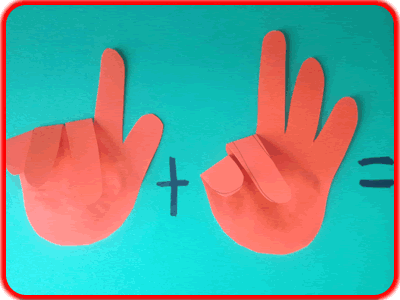
Hands Up Addition
Cut hands out of construction paper and glue down the palms. Bend the fingers on each hand to make sets.
• Use for addition, more/less, etc.
Math Mat
You will need a square sheet of paper to make a math mat.
Draw lines similar to the ones shown. Explain that the line in the middle is like the equal sign in an equation. What is on one side has to equal what is on the other side. Demonstrate how to make a set in the top left section and a set in the top right section. Count. Pull down the objects into the bottom section and count how many altogether.
• Use divided plates in a similar manner.
Fist Fast Math - Here’s a “quickie” math game that is like “rock, scissors, paper.” Each child will need a partner. Children open one palm. Make a fist with the other hand and place it on the palm. The teacher says, “Fist, fast, math” as children tap their fist on their palm. On the word “math” the children stick out some fingers. Children add their fingers with their partner’s to determine how many in all. If they agree, they continue with the game. If they disagree, they have to work it out.

Spill the Beans - You will need large dry lima beans, spray paint, and breath mint tins for this project. First, spread the lima beans on newspaper and spray paint one side. Give each child five beans to put in their container. Close the lid and shake the beans. How many white beans? How many painted beans? How many altogether? Can you write that equation down? Let children continue to shake the beans and write the different combinations for five.
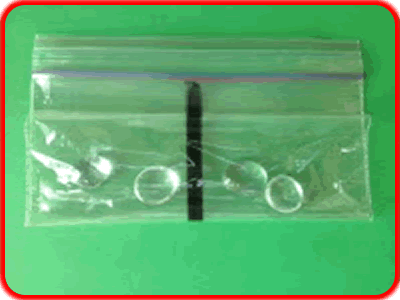
Math Bags
You will need zip sandwich bags and small, flat objects such as buttons or glass pebbles for this activity. Draw a line down the middle of a bag with a permanent marker. Insert objects in the bag. Children slide the items from one side to the other to make different combinations.
Can they write down the different combinations?
Calculator Math
Draw a grid similar to the one shown on the sidewalk with chalk. The teacher gives a number to a child and she must jump on a math fact that equals that number. For example, if the teacher says “3” the child can jump on “2 “ and “1.”
Hint! You could also draw this grid on a shower curtain to use for inside math games.
Number Friends (Tune: “Bingo”)
There are some friends that equal number
That you should all know.
2 + 4, 3 + 3, 5 + 1, all equal six you know.
• Let children brainstorm facts for other numbers and sing them in the song.
Friends of Ten
You will need colored construction paper to make this game. Write 0 and 10 on red paper. Write 1 & 9 on green paper. Write 2 & 8 on yellow paper. Write 3 & 7 on blue paper. Write 5 & 5 on orange paper. Pass out the numerals to the children. They have to walk around and find their “friend” so they equal ten.
NUMBER AND OPERATIONS IN BASE TEN
Work with numbers to gain a foundation for place value.
Count with Style
Count each “ten” with a different style.
Quiet 1’s (Whisper)
Terrible Teens (Growl)
Roaring 20’s (Loud)
Twisty 30’s (Do the twist)
Jumpy 40’s (Jump)
Flying 50’s (Spread arms)
Sick 60’s (Hold nose and pretend you have a cold)
Spooky 70’s (Ghost voice)
Flip Pancakes 80’s (Pretend to flip pancakes)
Laughing 90’s (Hold stomach and laugh)
Jump and Cheer for 100!!!
Tens and Ones (Ginger McCormick)
(Cadence – Children repeat each line.)
I don’t know but I’ve been told. (Repeat)
Tens are tall and ones are small.
First you count up all the tens.
Then add the ones to the end.
• Pick students to be tens and stand tall.
• Pick students to be ones and sit criss-cross in front of the tens.
• Count the tall students by tens.
• Count the students sitting on the floor by one.
What’s the number?
Clap and Snap
Explain that you will clap your hands for the tens and snap your fingers for the ones. Children will have to listen closely to see if they can figure out the mystery number. For example: clap, snap, snap, snap, snap = 14
• Stomp for hundreds, jump for thousands, and so forth.
Two Card Deal
Remove two sets of playing cards with the numbers 1-10 from the deck.
Shuffle sets separately and place on the table. Write “tens” on one index card and place above the cards on the left. Write “ones” on another index card and place above the cards on the right. Children take turns drawing cards and saying how many tens, how many ones, and the number. For example: “I have 3 tens and 7 ones and that’s 37.”
MEASUREMENT AND DATA
Describe and compare measurable attributes.
Kitty-Cat! Position Scat! (Tune: “Turkey in the Straw” – Totally Math CD)
Kitty-cat, kitty-cat stretch up high; (Point up.)
Kitty-cat, kitty-cat touch the sky.
Kitty-cat, kitty-cat, reach down low; (Point down.)
Kitty-cat, kitty-cat, don’t be slow!
Kitty-cat, kitty-cat, point to the right; (Point right.)
Kitty-cat, kitty-cat, out of sight! (Hands over eyes.)
Kitty-cat, kitty-cat, now point left; (Point left.)
Kitty-cat, kitty-cat, you’re the best!
Kitty-cat, kitty-cat, step out front; (Step forward.)
Kitty-cat, kitty-cat, what a stunt!
Kitty-cat, kitty-cat, walk behind; (Walk backwards.)
Kitty-cat, kitty-cat, please be kind.
Kitty-cat, kitty-cat, crawl below; (Get down on hands and knees.)
Kitty-cat, kitty-cat, to and fro.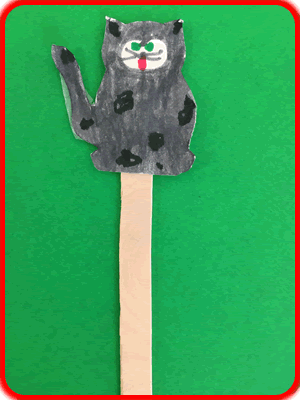
Kitty-cat, kitty-cat, climb above; (Pretend to climb up with arms.)
Kitty-cat, kitty-cat, you I love.
Kitty-cat, kitty-cat, go between; (Put hand between legs.)
Kitty-cat, kitty-cat, don’t be mean! (Shake finger.)
Kitty-cat, kitty-cat, now jump over; (Jump up.)
Kitty-cat, kitty-cat, roll in the clover. (Roll arms around.)
Kitty-cat, kitty-cat, now creep under; (Put right hand under left arm.)
Kitty-cat, kitty-cat, you’re a wonder.
Kitty-cat, kitty-cat, reach to the side; (Reach left and then right.)
Kitty-cat, kitty-cat, smile with pride. (Smile.)
Kitty-cat, kitty-cat, be my friend; (Hold up left hand and pretend to
Kitty-cat, kitty-cat, that’s the end! stroke like a kitten with right hand.)
Kitty-cat, kitty-cat, you know where you’re at.
Kitty-cat, kitty-cat, time to scat! (Slap hands.)
Activities: Cut small kittens out of construction paper and staple to straws to make stick puppets children can manipulate as they sing.
Longer and Shorter (Angela Berthiaume)
Give each child 5 connecting cubes. Tell them to walk around the room and compare objects to their cube train using the words “longer” and “shorter.” But, they must use a whisper voice and only use the words “longer” and “shorter.” If they talk, they must sit down.

Cheez-It Measuring - Did you know that Cheez-Its are one inch squares? What a great way to measure!
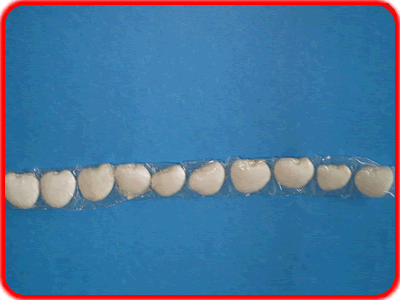
Bean Counters - You will need clear packaging tape and large dry lima beans to make a bean counter. Place ten lima beans end to end in the middle of the tape as shown. Fold the top of the tape down, the bottom up, and seal. Trim off the ends. Children take the bean counter and place it on the end of the object to be measured. How many beans long is the object?
Block Measurement

Let children use unit blocks to measure classmates. Classmates lay on the floor and children place square blocks next to them to determine “how many blocks” they are. Measure with rectangular blocks and compare results.
Classify objects and count the number of objects in categories.
Leaf Hunt
Take children on a nature walk to hunt for leaves. (Remind them to
only pick up leaves off the ground. They should never pull leaves off of
plants.) Ask each child to select two leaves. When you return to the
classroom put the leaves in a pile in the middle of the floor. How can we
sort them? After children select an attribute, let them sort the leaves.
Count the number in each set. How else can we sort them? Can you think of another way?
• Sort rocks, shells, sticks and other natural objects.
Hint! When children sort objects it is important to have them verbalize
their sorting rules. How are they alike?
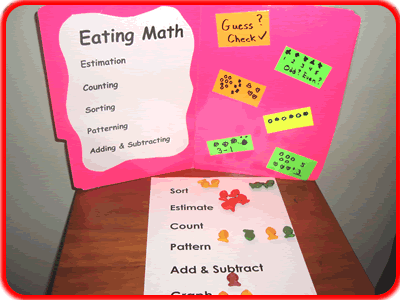
Eating Math
If you really want children to remember something, let them sing it or eat it! Fill snack bags with ½ cup of cereal (with different colors or shapes) or party mix. Have children do some of the activities below with the cereal in their bag:
• Sorting- Sort the cereal by color, shape, or size.
• Estimation- How many pieces are in your bag?
• Counting- Count and see how many you have. Did you estimate more or less?
• Is it an odd or even number?
• Use cereal for addition and subtraction.
Question of the Day
Let children sort into groups based on a particular attribute every morning as they arrive at school.
For example, you might write “Do You Have Pockets?” YES NO
Children write their name under their response.
Count the results at morning meeting and compare numbers.
Hint! Start with a simple question with two responses and then increase to three or four responses.
For example, “Do you have a pet?” DOG CAT OTHER NONE
Block Graphs – Tape photos of children on square unit blocks. Use these for graphing eye color, letters, in their name, birthday month, favorite
game, favorite author, type of shoes, and so forth.
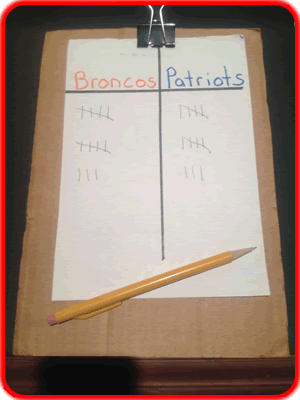
Data Collectors – Let children collect data from friends and family using a T-chart. You could tie it in with a unit (Do you like dogs or cats?),
sports events (Who will win March Madness?), favorite food (Do you like cheese pizza or pepperoni?), and so on.
Let children tally their results on
the board when they bring their data back to school.
Glyphs
Glyphs are a challenging way to integrate reading skills, math concepts, decoding, small motor skills, and problem solving. You can create glyphs for different seasons, units of study, or anything your students are interested in.
Give each child a cutout of a teddy bear, leprechaun, monster, etc.
Write the following directions on a language experience chart. Read the directions step-by-step as the children create their “personalized” bear.
If you are a boy, draw a bow under his chin.
If you are a girl, put a bow on the head.
What color are your eyes? Make the eyes on your cutout
the same color as your eyes.
Do you have brothers and sisters? Make buttons on the character for the number of siblings that you have.
How do you feel today? Make the mouth on your character to show how you feel.
Do you like to play sports? Draw shoes on the character to show your favorite sport.
What are your favorite hobbies? Put an object to represent something you enjoy in one of the character’s hands.
Draw an ice cream cone in the other hand. Make the ice cream the color of your favorite flavor.
How old are you? Can you use that many colors on your character?
Give your character a name!
Time
Hickory Dickory Dock (Traditional Tune – “Sing to Learn” CD)
Hickory dickory dock. (Fold hands and tick tock back and forth.)
The mouse ran up the clock. (Run fingers up in the air over head.)
The clock struck one, (Clap one time.)
The mouse ran down. (Run fingers down.)
Hickory dickory dock.
Two – “Yahoo!” (Continue doing the movements above,
Three – “Whopee!” clapping the appropriate number of times.)
Four – “Do more!”
Five – “Let’s jive!”
Six – “Fiddlesticks!”
Seven – “Oh, heavens!”
Eight – “Life’s great!”
Nine – “So fine!”
Ten – “We’re near the end.”
Eleven – “We’re sizzlin’.”
Twelve – “I’m proud of myself.”
• Use your arms like the hands on a clock. Extend both arms over your head. On “one,” bring right arm down to the position of “one” on a clock. On “two,” bring right arm down to position of “two,” and so forth as you sing.
Days of the Week (Tune: “The Addams Family” Dr. Jean & Friends CD)
Days of the week. Days of the week. (Snap fingers.)
Days of the week. Days of the week.
Days of the week.
There’s Sunday and there’s Monday, (Cross over right hand to tap
There’s Tuesday and there’s Wednesday, left knee and then left hand
There’s Thursday and there’s Friday, to tap right knee.)
And then there’s Saturday.
• Point to the days on a calendar as you sing.
• Learn to sing this song in sign language or another language.
Months of the Year (“Dr. Jean & Friends” CD)
January, (Left arm out palm down.)
February, (Right arm out palm down.)
March, (Left palm up.)
April, (Right palm up.)
May, (Right hand on left shoulder.)
June, (Left hand on right shoulder.)
July, (Right hand on back of head.)
August, (Left hand on back of head.)
September, (Right hand on left front hip.)
October, (Left hand on right front hip.)
November, (Right hand on back right hip.)
December, (Left hand on back left hip.)
Then you turn around. (Hands on hips and wiggle.)
Digital Time - Place a digital clock by the wall clock in your classroom so children can associate both ways of telling time.
Giant Clock - Write the numerals 1-12 on paper plates. Arrange these on the floor to resemble a clock. Cut out 2 hands from construction paper. Attach one to the end of a ruler (hour hand) and one to the end of a yardstick (minute hand). Children arrange the hands on the floor to simulate the hands on a clock.
Money
Found a Penny (Tune: “Found a Peanut” Totally Math CD)
(Hold up real coins or cut outs as you sing.)
Found a penny, found a penny, found a penny just now.
It is round and brown and shinny
Found a penny just now.
I see Lincoln, I see Lincoln, our sixteenth president,
On the back is his Memorial
Penny, penny’s worth one cent.
Found a nickel, found a nickel, found a nickel just now.
It is round and fat and silver
Found a nickel just now.
I see Jefferson, I see Jefferson, our third president
On the back his Monticello
Nickel, nickel’s worth five cents.
Found a dime, found a dime, found a dime just now.
It is thin and small and silver,
Found a dime just now.
I see Roosevelt, I see Roosevelt, our thirty-second president
On the back is a torch.
One dime is worth ten cents.
Found a quarter, found a quarter, found a quarter just now.
It’s the largest of all the coins,
Found a quarter just now.
I see Washington, I see Washington, our first president
On the back the bald eagle;
Quarter’s worth twenty-five cents.
Found a dollar, found a dollar, found a dollar just now.
It has a picture of George Washington
And it’s worth one hundred cents.
Five pennies equal a nickel; ten pennies equal a dime.
Twenty-five pennies in a quarter,
Two nickels equal a dime.
Five nickels in a quarter, or a nickel and two dimes;
Four quarters in a dollar
And a dollar equals ten dimes.
Rubbings - Have children do rubbings of coins. Place each coin under a sheet of paper and rub with the side of a crayon. Who do they see? What’s it worth? Let children examine coins with a magnifying glass. Encourage them to discuss details. How old is the coin?
Money Song (Tune: “Shortnin’ Bread” Is Everybody Happy? CD)
Chorus: I like money to buy things at the store. (Point to self.)
Money, money, money,
I always want more! (Palms up and shake.)
A penny’s worth one cent. (Hold up 1 finger.)
A nickel’s worth five. (Hold up 5 fingers.)
A dime’s worth ten cents. (Hold up 10 fingers.)
A quarter’s twenty-five. (Open and shut hands for 25.)
Chorus
Lincoln’s on one cent.
Jefferson’s on five.
Roosevelt’s on ten cents.
Washington’s on twenty-five.
Chorus
A building’s on one cent.
A building’s on five.
A torch is on ten cents.
An eagle’s on twenty-five.
Chorus
Hint! Sing “Let’s learn some more!” instead of “I always want more.”
Coin Value Song (Paris Garrett)
(Tune: “Who Let the Dogs Out?”)
Who let the penny out?
1, 1, 1, 1 (Hold up one finger.)
Who let the nickel out?
5, 5, 5, 5 (Hold up five fingers.)
Who let the dime out?
10, 10, 10, 10 (Both hands up.)
Who let the quarter out?
25, 25, 25, 25 (Two fingers on one hand and five fingers on the other.)









